A little history. Smith & Wesson rocked the American handgun world in 1858 when they introduced the Model 1 revolver. This was a 7-shot, single action, that chambered a .22 rimfire fixed metallic cartridge. It has a tip-up frame that limited the size of cartridge it could take and later, the Model 2 and Model 1-1/2 were introduced in .32 rimfire. But S&W wanted to offer a big bore revolver, so they developed a large hinged frame sixgun they called the Model 3 American. In this case, the barrel tipped down, and the spent brass in the cylinder was automatically ejected. This made reloading fast and easy, which made for immediate interest by the military and civilians. S&W also developed a centerfire .44 cartridge for this revolver called the .44/100 “American.” Like their .22 cartridge, it had a bullet the same diameter as the case and was outside lubricated. By December 1870, they had received a U.S. Government contract for 1,000 Model 3 revolvers. However, S&W had bigger ideas.
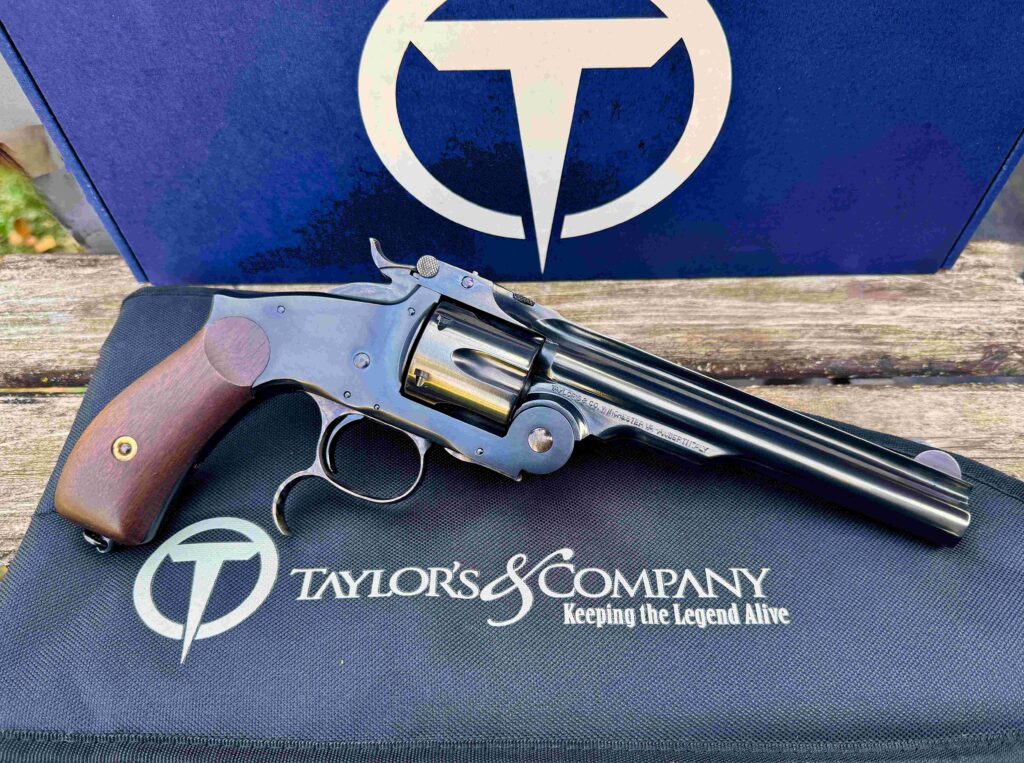
A recent offering from Taylor’s & Co. is this Model 3 Russian, a replica of the S&W Model 3 Russian, 3rd Model of 1874; it has a nice padded carrying case.
A Russian general was in the U.S. overseeing the production of rifles being manufactured for the Czar’s government. S&W approached him about a contract for their new revolver. While the general was impressed with the six-shooter, the cartridge wasn’t satisfactory. What the Russians wanted was a round where the bullet was smaller than the case and inside lubricated. S&W came up with a cartridge that met these specifications; it had a 246 gr. bullet, propelled by 23 gr. of black powder, and a velocity of 750 FPS. The history-making .44 Russian was born. The Russians contracted for 20,000 revolvers in May 1871. As production began, improvements were made to the design and the Russians also required some specification changes. As the Model 3 Russian evolved, it went through to the final Model 3, Third Model or New Model Russian in 1874. This revolver had a 6-1/2” barrel, an improved extractor/ejector with a smaller housing below the barrel, a “knuckle” at the top of the backstrap, and an unusual spur incorporated into the bottom of the trigger guard. In total, the Russians contracted for 70,000 of these S&W revolvers. Naturally, they also caught on in the U.S. with frontiersmen, lawmen, and outlaws alike. Supply could not keep up with demand.
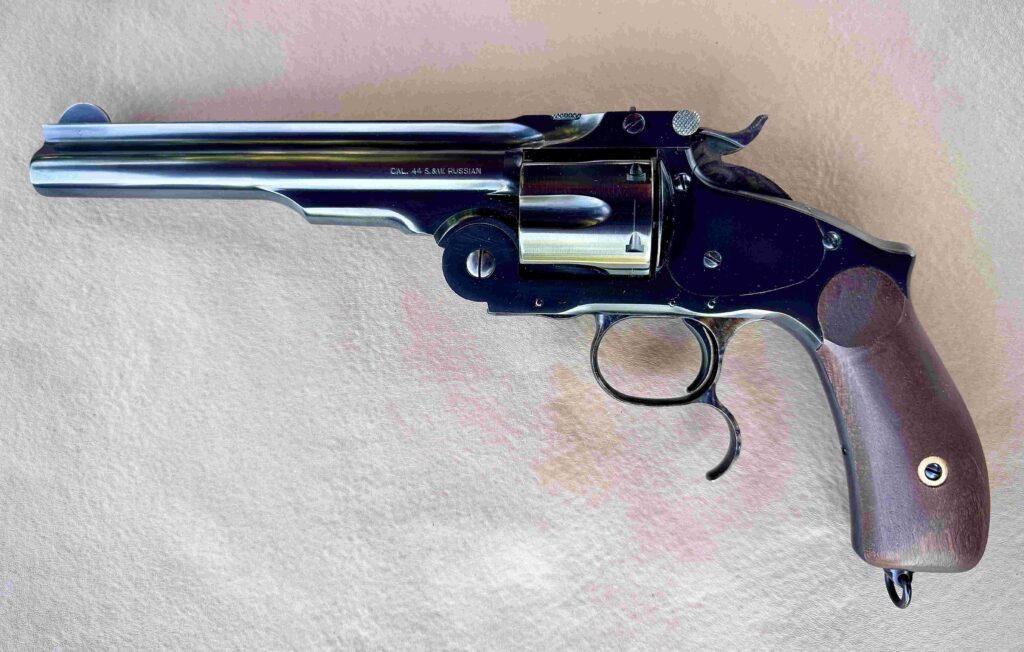
The final iteration of the Model 3 Russian has a 6-1/2” barrel, blue finish, and unlike later S&W revolvers the cylinder rotates clockwise.
I was excited to learn recently that Taylor’s & Co. had received a shipment of replica S&W Model 3 Russian revolvers in .44 Russian. I wasted no time requesting a test gun. The Uberti-made test gun arrived in short order. It was packaged in a blue cardboard box with an owner’s manual, and the revolver itself rode inside a black nylon padded case, with a Velcro closure flap. It had a polished blue finish, with contrasting color case-hardened parts like the hammer, trigger guard, ejector lever, and locking latch. Carefully looking it over, I noted the attention given to fit and finish, with no defects or blemishes visible on the exterior surfaces.
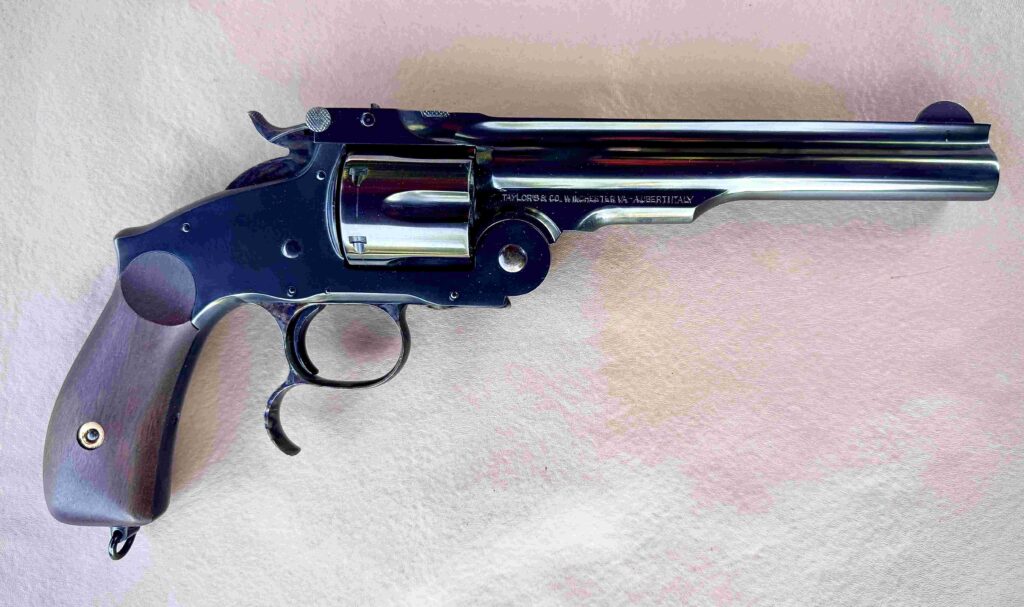
Having a hinged frame allowed the Model 3 to chamber larger cartridges, unlike the early tip-up barrel S&W revolvers that took .22 and .32 rimfire ammunition.
An integral rib atop the barrel runs back from the muzzle, and forms the top-strap. A half-moon front sight is pinned to the rib, and the rear locking latch is attached to the rear of the top-strap. The latch has two small posts that jut up and serve as a rear sight. A projection from the rear of the latch mates with a notch in the hammer face, serving as a locking point, when the hammer is at rest. A large hinge at the front of the frame is the attachment point for the barrel, top-strap, and latch assembly. Interestingly, the side-plate on the Model 3 Russian is on the left side of the frame, and the cylinder rotates clockwise, unlike later S&W revolvers. The “spur” trigger guard is pinned into the bottom of the frame. Measuring ¼” in width, the trigger is smooth-faced, and my Lyman Trigger Pull Gauge, shows it has an average pull weight of 5 lbs. 10 oz., with a hint of creep. The hammer spur is sharply upturned and checkered. Integral with the hammer face, the long, pointed firing pin protrudes through the breech-face when the hammer is fully at rest. For safety, the chamber under the hammer should be left empty. To open the top-latch, the hammer must be cocked to the first “click,” and there’s no half-cock.
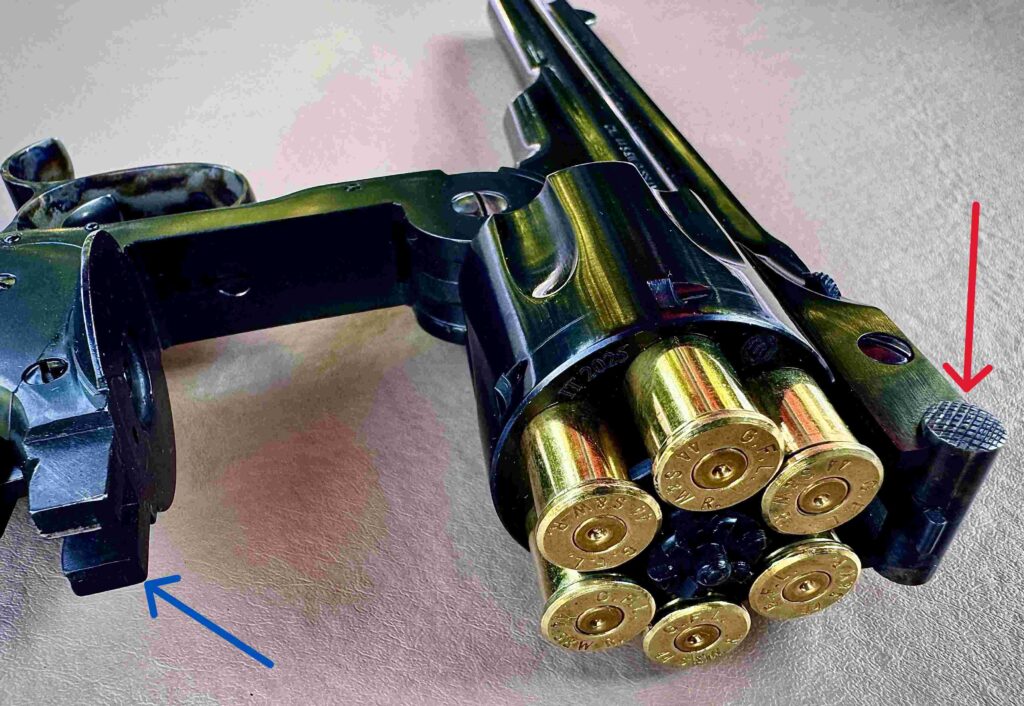
Lifting the top-latch (red arrow) allows the revolver to be broken open and the barrel lowered to reload; the latch secures to the two frame studs (blue arrow).
The two-piece grips are walnut and appear to have an oil finish. On the butt of the grip frame is a small lanyard ring. Hopefully, you’re aware by now, that this is a single action revolver, meaning the hammer must be manually cocked for each shot. Unlocking the top-latch and swinging the barrel/cylinder unit downward raises the ejector rod/star, extracting the cartridge cases, and then the rod/star snaps back into place, ejecting the spent cases. Removing the cylinder for cleaning, requires the stop cylinder plate screw on the top strap, just ahead of the locking latch, to be fully unscrewed. Next, the latch is unlocked and the barrel fully swung down. The rear edge of the stop cylinder plate is visible and a small downward extension secures the cylinder in place. Using a thin-blade screwdriver, get under the plate ledge and pull it out about ¼.” Now, pull the cylinder off its base pin bushing. It is replaced in reverse order.
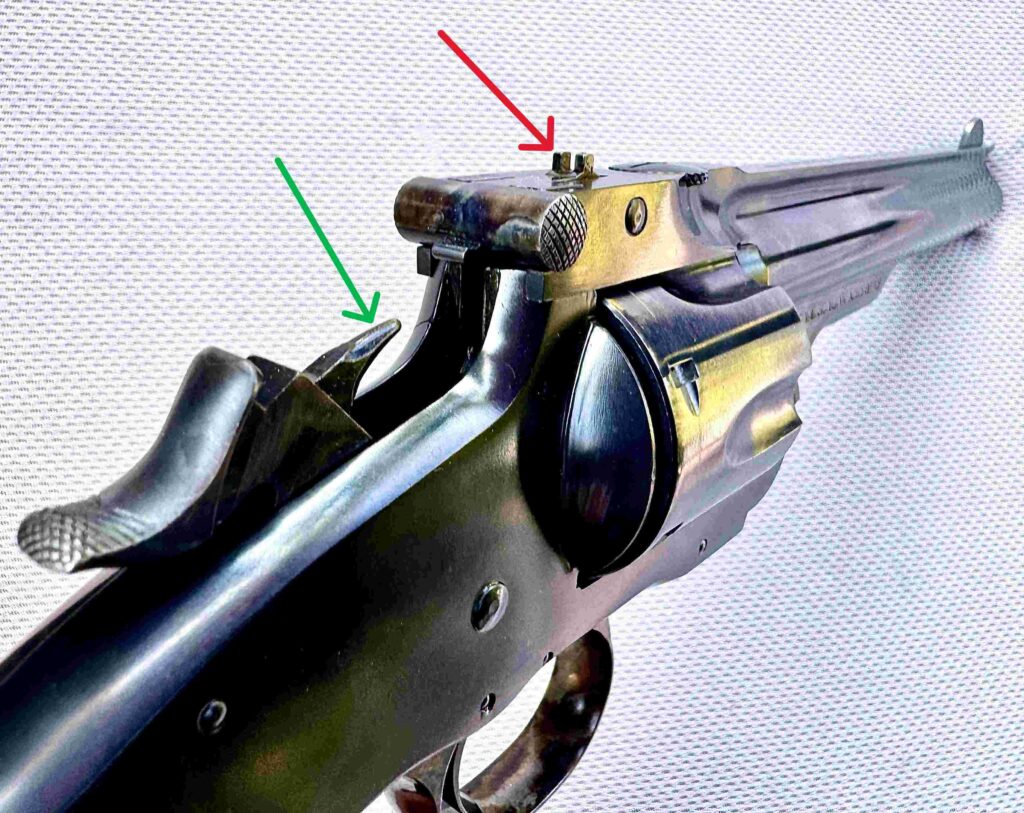
The Model 3 rear sight is integral with the top-latch and looks like two small posts (red arrow); note the firing pin on the nose of the hammer (green arrow).
There isn’t a plethora of .44 Russian ammunition out there. I still had a supply of Black Hills Ammunition in this caliber, left over from a previous gun test. It has a 210gr. flat-point lead (FPL) bullet. Buffalo Arms sent me samples of their .44 Russian “cowboy” load. It has a 200gr. lead, round-nose, flat-point (RNFP) bullet, and 50 rounds come packaged in a reuseable plastic, hinged-top box. Hunting Shack Munitions (HSM) supplied their Cowboy Action Cartridges, which have a 200gr. lead, RNFP bullet. I also received Cowboy Action loads from Fiocchi. Their .44 Russian cartridges have a 247gr. lead, round nose (RN) bullet, which has a black coating.
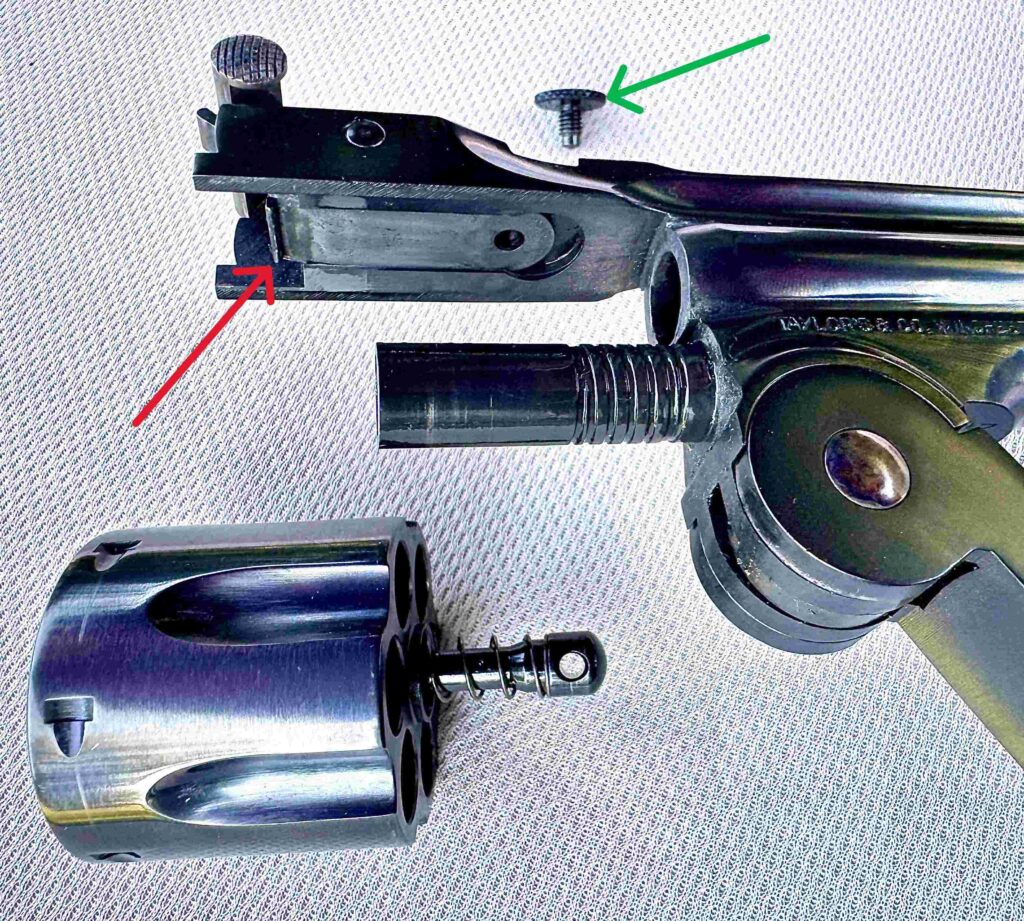
A small lip protruding from the stop cylinder plate (red arrow) keeps the cylinder secure; to remove it, turn out the large screw on the top strap (green arrow).
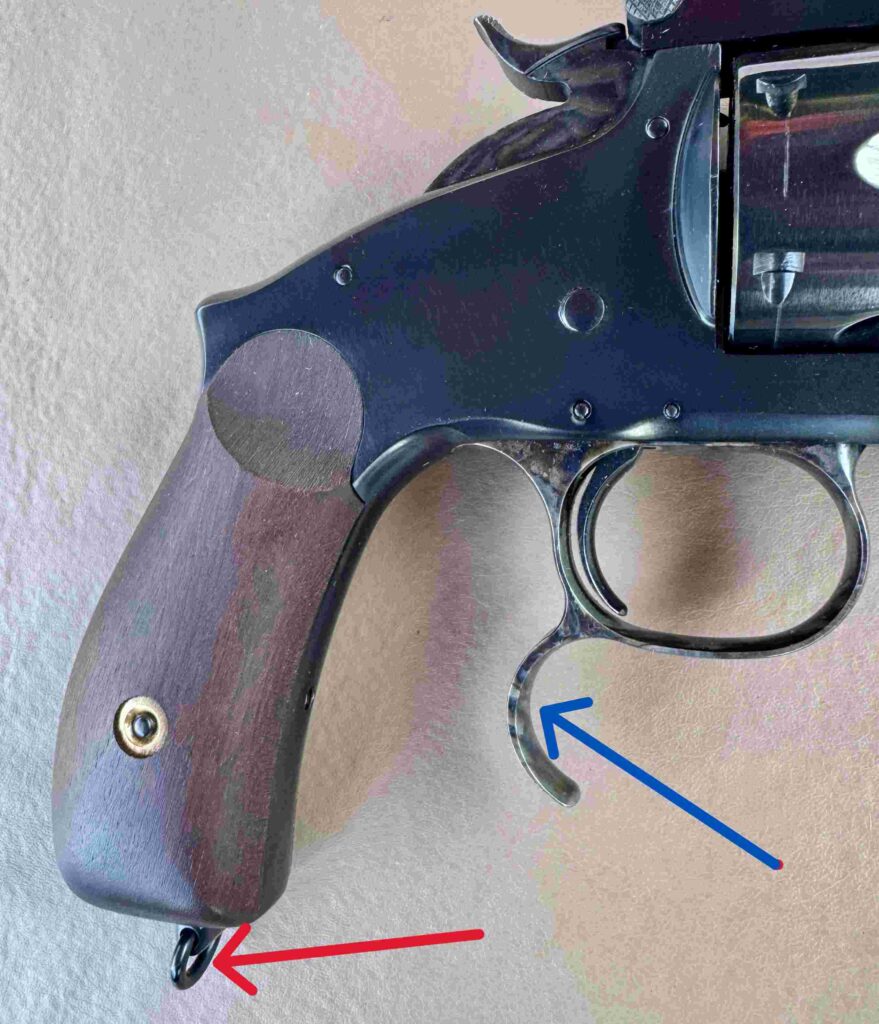
The Russian military specified the unusual spur on the Model 3 trigger guard (blue arrow); on the butt of the grip is a small lanyard ring (red arrow).
I was able to get everything squared away, enabling me to do some shooting with the Model 3 Russian before taking it out to a Cowboy Action Shooting (CAS) match. At the range, I sent a large Caldwell Orange Peel bullseye target down to the 10 yard line, set up my Xero C1 Pro chronograph, and got bullet velocity measurements on the test ammunition. I used the target at the same time to get an idea of the revolvers point-of-aim/point-of-impact. Elevation was on the money, but the gun tended to shoot left of center. The bullet velocity data is in the performance table. For an evaluation of the sixguns accuracy potential, I used some smaller Birchwood Casey bullseye targets, set at 36 feet. Three 5-shot groups from each test load were fired from the bench, using a Ransom Steady Rest. The tightest group measured 0.77” and was made using the Fiocchi cartridges. Group averages ranged from 1.56 to 2.25.” For centered bullet impacts, I usually held the front sight at 1:00 o’clock from the red aiming circle.
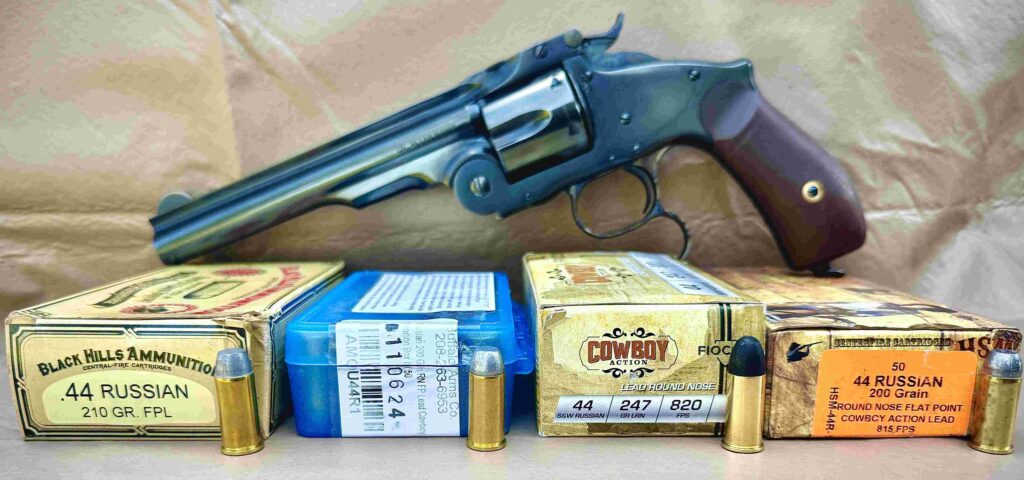
Four brands of factory .44 Russian cartridges were used in the Model 3 T&E; they were from Black Hills, Buffalo Arms, Fiocchi, and HSM.
To simulate the shooting I’d be doing at the CAS match with the Taylor’s Model 3 Russian, I sent a Birchwood Casey “Cowboy” Splattering Target to the 10yard line. It’s rectangular, measures 12×18 inches, and is just about the size of a steel handgun target at a cowboy shoot. Twenty shots of mixed test ammo were fired at the target from a standing, isosceles stance, using a two-handed hold. Shooting was done as quickly as I could cock the hammer, find the sight picture, and press the trigger. All my shots stayed inside the targets 7.5×4.5”, center-mass scoring area, so I felt the gun and I would be ready to ring steel at the outdoor cowboy range.
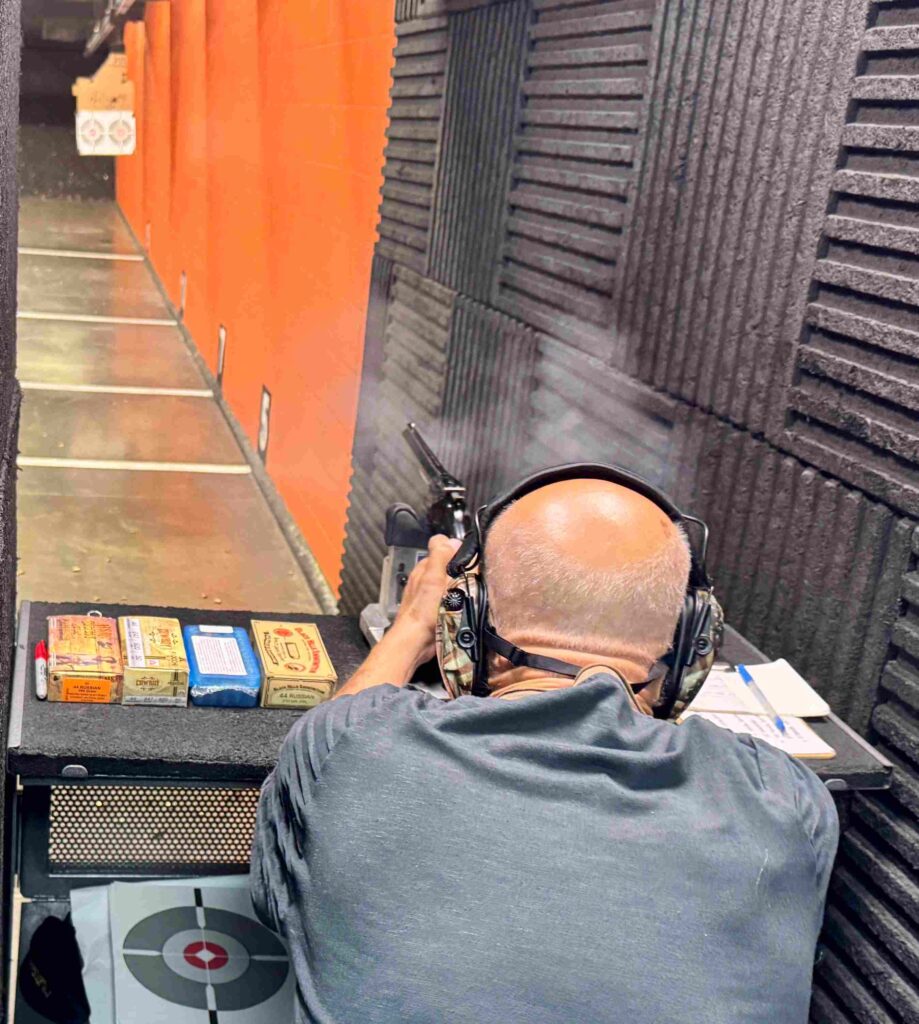
Accuracy testing was done at an indoor “square range” with shooting from a rest, at a distance of 36 feet; three 5-shot groups were fired with each test cartridge.
The match I attended was put on at the cowboy town range run by the Knob Creek Gunfighters Guild, a Single Action Shooting Society-affiliated club. There were six main match stages, with a break after the first 3 stages for lunch. Being 71 years old, I qualified to shoot in the Elder Statesman classification. Along with the Model 3 Russian, I used a Single Action Army replica in .44 Special; from which I shot .44 Russian ammo. My rifle was a well-used Rossi Model 92 in .45 Colt, and I had my 12 ga. Stoeger Coach Gun double-barrel. As I had a good supply of Black Hills and Fiocchi .44 Russian cartridges, I used them during the match.
Unfortunately, my performance on the first two stages was less than ideal, but as the day wore on, my shooting improved. I only had a couple of misses with the Model 3 Russian and found I had to go a bit slow with the replica S&W due to the tiny rear sights. The sight picture looked like three posts and I had to be sure I had the front sight between the two rear posts and not off to one side or another. To me, the Model 3 Russian just doesn’t point as naturally as my SAA six-shooters. Of course I use them all the time, so I’m more familiar with their “feel.” The Russian also seems to have a more muzzle-heavy balance. To the delight of the U.S. Cavalry and civilian users, the Model 3 was, and is, much faster to break open, eject the spent brass, and reload with fresh cartridges, than the Colt Model 1873. I discovered that the curious trigger guard spur helped with my two-handed hold, when cocking the hammer with my support-hand thumb. I enjoyed shooting this offering from Taylor’s & Co., and even managed to take second place in my classification at the CAS match.
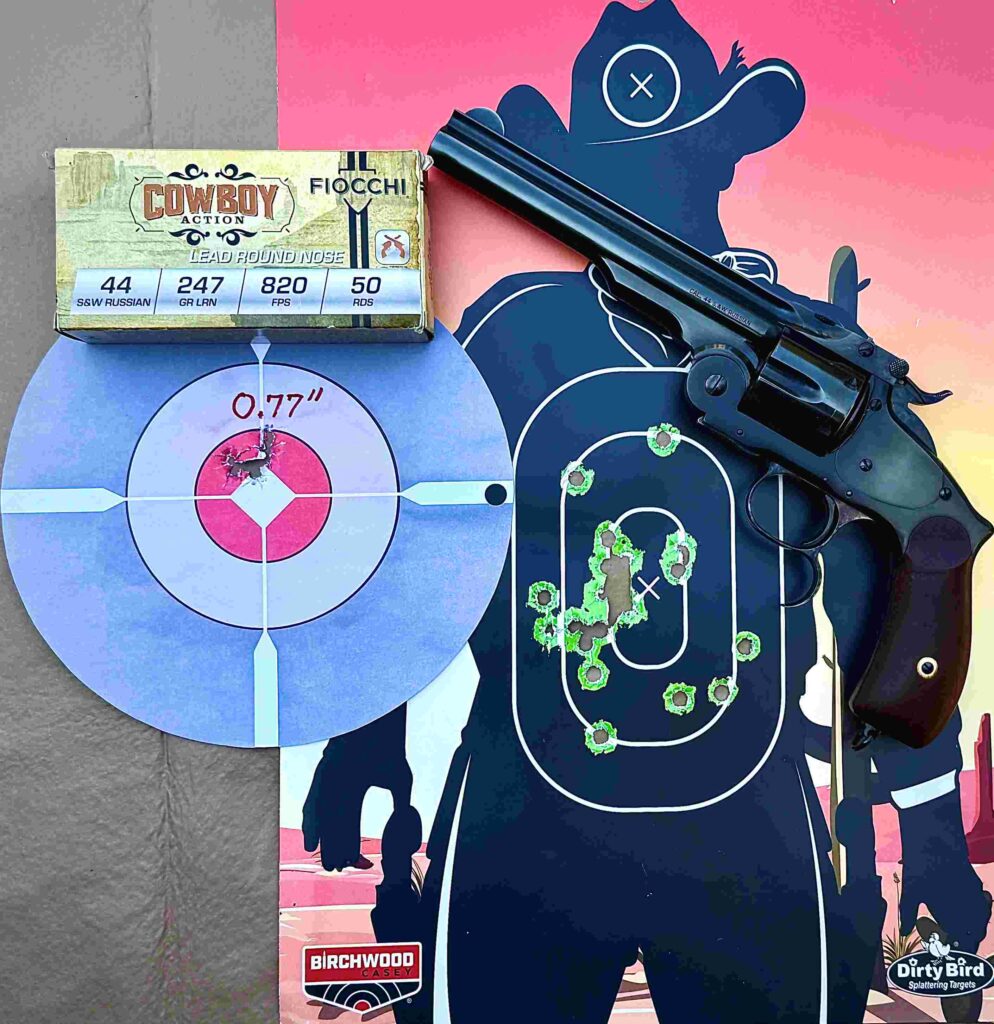
The best 5-shot group was made using the Fiocchi .44 Russian ammo; twenty shots were fired standing, with a two-handed hold, at the “cowboy” target.
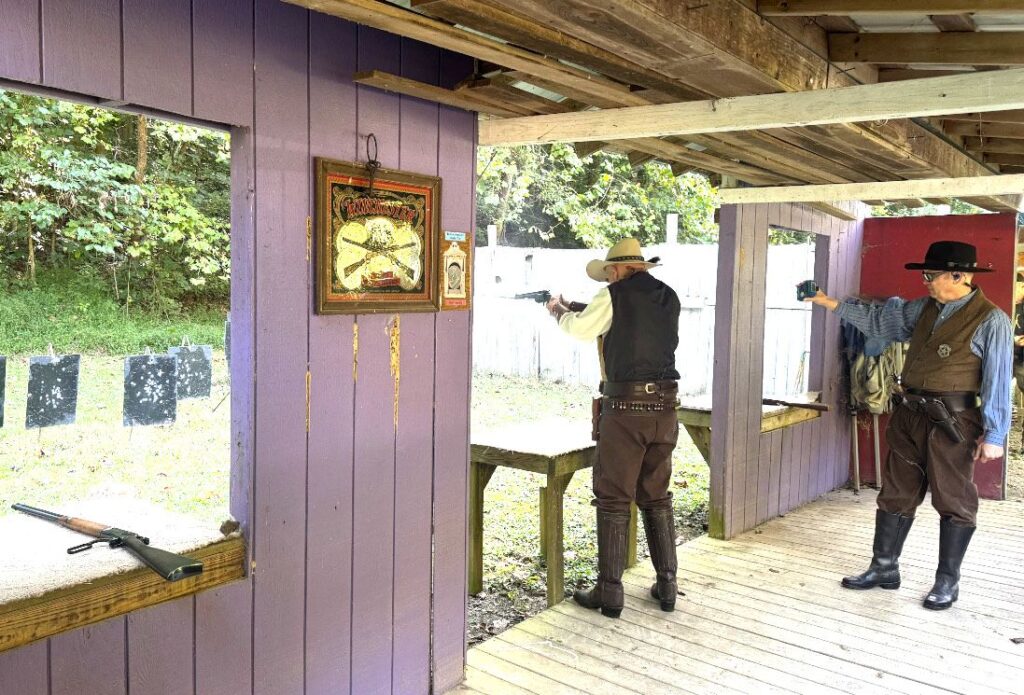
Here, the author is using the Taylor’s Model 3 Russian in a cowboy action shooting match put on by the Knob Creek Gunfighters Guild SASS Club.
Additional Information
Taylor’s & Co. www.taylorsfirearms.com
Single Action Shooting Society www.sassnet.com
Taylor’s Model 3 Russian Specifications
MECHANISM: Single action revolver
CALIBER: .44 Russian
CAPACITY: 6 cartridges
BARREL: 6.5”
OA LENGTH: 12.16”
EMPTY WEIGHT: 2.7 lbs.
SIGHTS: Fixed notch on latch rear, round blade front
FINISH: Blue
STOCKS: Two-piece walnut, smooth
MSRP: $ 1,504.21
Taylor’s Model 3 .44 Russian Performance
|
Cartridge |
Ave. Velocity |
Best Group |
Average Group |
|
Black Hills 210 gr. RNFP |
586 FPS |
1.88” |
2.25” |
|
Buffalo Arms 200 gr. RNFP |
565 FPS |
1.31” |
1.56” |
|
Fiocchi 247 gr. RN |
670 FPS |
0.77” |
1.00” |
|
HSM 200 gr. RNFP |
731 FPS |
1.81” |
2.01” |
NOTE: Bullet weight measured in grains, velocity in feet per second at 15” from the muzzle by a Garmin Xero C1 Pro chronograph, and accuracy in inches for three 5-shot groups at 36 feet.
To locate a dealer near you visit www.lipseys.com/dealerfinder
